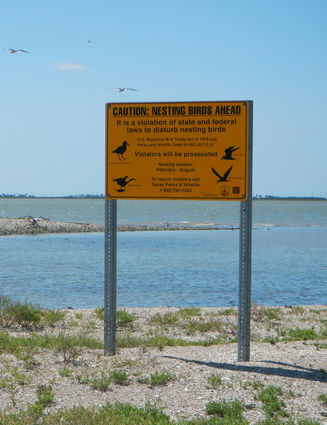Visitors to Galveston beaches urged to be aware of baby, nesting birds
Last updated 6/10/2015 at Noon
Recent surveys of Galveston Bay rookery islands reveal almost twice as many nesting birds as the previous year. The Gulf Coast Bird Observatory (GCBO) says more rainfall this past year has eased drought conditions in the Houston area and provided better breeding conditions for birds in and around Galveston Bay.
This means a larger-than-normal influx of oystercatchers, herons, egrets, terns, and other bird species is likely this breeding season, which starts in late spring and goes through summer. That’s why the GCBO, Audubon Texas and Houston Audubon are reminding people it’s against the law to disrupt nesting birds.
“As innocent as boaters and beachgoers may be, they are a threat to the birds,” said Felipe Chavez-Ramirez, director of conservation programs for the GCBO. “We’ve seen footprints imprinted on bird nests that are built on the ground. But people often say they didn’t see the birds or the nests.”
Disruption of nesting birds can destroy colonies and put baby birds at risk. Coastal birds may raise their families in shrubs, clumps of grass, or even on the open beach. To help these new birds survive and thrive, Galveston Bay visitors are encouraged to pay attention to the signals nesting birds are sending. They should be especially aware in wilder areas where ground-level nests may be present and more difficult to see. If a bird is faking a broken wing or diving toward you on the beach, you are near its nest. Leave the area and report the location to wildlife authorities.
Additionally, visitors can do the following to avoid nesting birds:
- Move away from birds if they get louder, fly off their nests, or move away from you.
- Anchor your boat at least 50 yards away from nesting islands.
Kayakers and wade fishers are also asked to stay off these islands.
- Don’t leave any equipment behind when fishing.
- Keep pets on a leash and away from nesting birds.
- Do not bury or leave trash, picnic leftovers, charcoal, or fish scraps on the beach.
They attract predators of chicks and eggs, such as grackles, raccoons, foxes, and laughing gulls.
- Do not set off fireworks.
The upper Texas coast is one of the United States’ premier birdwatching destinations, and more than 4 million people live near or along the shores of Galveston Bay. The Bay is also the boating capital of Texas and the second-largest producer of seafood in the country. At the same time, the Galveston Bay area is responsible for half of the nation’s petrochemical production.





Reader Comments(0)